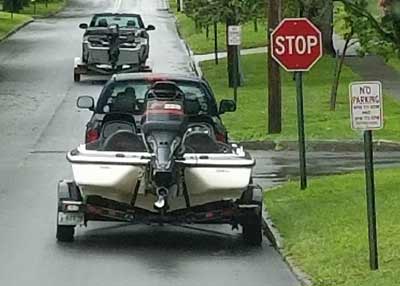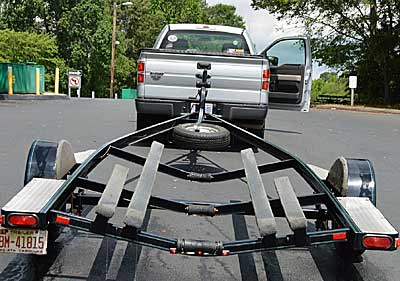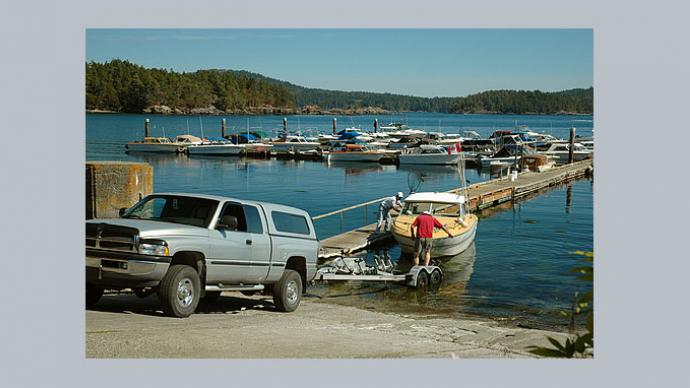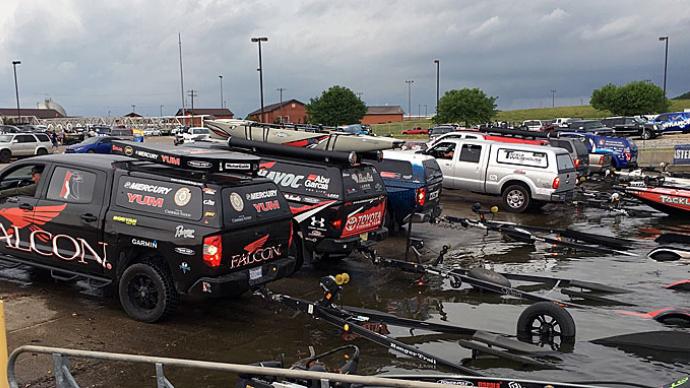
I had a small floor jack, so my boat trailer was in the air. I had the right socket and 1/2-inch drive breaker bar, so the flat tire was off the hub and on the ground. But I could not remove the last bolt holding the spare tire to my boat trailer. The bolt was seized, and I was stuck on the side of a busy South Carolina interstate as the sun set quickly on a long and tiring day of tournament fishing.
Lucky for me, my fishing buddy answered his phone. He was only 20 minutes up the road, so he backtracked, loaning me his trailer's spare tire so I could get home. While I signed up for road assistance specifically for my boat trailer the next day, a simple pre-trip inspection of the trouble-making fastener would have prevented the situation. But, of course, having a spare tire that's properly inflated and sporting good tread is only half the battle. It needs to be accessible, too.
If you ranked the worst feelings for bass anglers, being stranded on the side of the road with a broken boat trailer would be the top of the list. Losing a personal best or tournament-winning bass when it was mere inches from your hand may be the only one that surpasses it. If you've put enough miles on your fishing rig, the chances are good that you’ve found yourself in a predicament. But there are things you can do now to prevent trailer trouble from happening to you — again or for the first time. Checking your spare tire is one. Here are nine more:
-
Check your route
GPS and mapping on cellphones or built into your tow vehicle are superb. Punch in your destination, and either will get you where you’re going, turn by turn, usually without issue. But sometimes, it calls out directions too late, especially when you're in heavy traffic and in the wrong lane. Some pre-planning is helpful, too, especially if you’re headed somewhere new.
Put your route into Google maps and pull up the satellite view. Zoom in to see details such as landmarks where you need to turn into the launch ramp or the proper lane to access an interstate. It can even help you find a gas station with enough room to swing your trailer and boat around to a pump. And if you need a better look, use the street-view function.
-
Check your mirrors
While you need to watch for trouble before towing, you also need to watch things while you're going down the road. So, ensure all your tow vehicle's mirrors are correctly adjusted.
You want a clear view of your trailer’s back corners and tires. That will help you blend in and out of traffic and possibly catch an issue, such as a tire going soft or smoke from an overheated bearing before it escalates. If you use a truck camper or an RV, you may need mirror extenders, according to AAA Carolinas.
Learn how to back up a trailer only using a vehicle’s mirrors. While turning around to look out the rear window makes the task easier initially, you eventually will run into a situation where that option isn’t available, whether in a new tow vehicle or when backing up your buddy’s truck. For example, a camper or cap, even a tonneau cover, can hide an empty trailer if the truck is tall enough or a trailer short enough.
-
Check your hitch
As bass boats have grown bigger and heavier, bumper hitches have given way to receiver-style hitches. Mounted to a tow vehicle’s frame, they are a safer and sturdier option. But they still require proper setup and periodic inspection.
Choose a receiver that works best with your vehicle and trailer. Receivers are available in various drops, which can rotate 180 degrees to create rises. Choose one and orient it so your trailer rides level when hitched to your tow vehicle. That will increase stability at highway speeds and keep the front or back from scraping on the road when going over bumps, starting up, or going down sharp inclines.
Double-check your connections before you leave home or the launch and when you stop during a trip. Ensure the hitch’s latch is secure and your safety chains or cables — which need to be long enough not to bind while turning — are in good shape and connected. And most importantly, make sure the receiver's retaining pin is in place and secured with at least a cotter pin. A locking pin is a better option. Not only does it keep the pin in place, but it deters thieves, who could remove a traditional pin, push back the trailer while it’s still locked to the receiver, and insert it into the getaway vehicle.
-
Check your lights
Trailer lights — brake, marker, and others — are vital for your safety and that everyone else shares the road. But they have been a source of frustration since day one. They are notorious for working one minute and not the next, though the new generation LED lights have increased reliability. But the chance of issues remains because they’re submerged twice every fishing trip. And from a young age, we all learn that water and electricity don’t mix.
Start where your trailer lights plug into your vehicle. First, make sure the connection is clean. If there's corrosion, use a rolled-up piece of fine-grit sandpaper, or something similar, to remove it from the male and female ends. A bit of dielectric grease on both ends will help prevent future issues.
Follow the wires back through the trailer, looking for spots where they have chaffed. Add wire wrap to prevent further wear if it's started but limited to the insulation. If it's down to the wire, look at a replacement.
While a wire inspection is only needed periodically, it's good to walk around your rig while its lights are illuminated at least once per trip to ensure all are working. And it doesn't hurt to carry at least a spare brake-signal light. Most plug-in making replacing one easy anywhere or anytime.
-
Check your tires
Your boat isn’t going anywhere without tires. So, take time between and before trips to ensure they are ready to roll.
Air pressure should be first on your checklist. Fill your tires to their manufacturer's recommended pressure. Properly inflated tires do three things. First, they minimize the tire's contact patch, reducing drag and improving fuel economy. They roll easier, reducing wear on bearings within the hub. And finally, they wear better, extending their life. Investing in a quality tire pressure gauge and a small air compressor — the pancake style ones used to power pneumatic nailers and staplers are perfect — is a smart move for your garage.
Visually inspect your trailer’s tires each time you wash your fishing machine. Look for cracks and bulges in the sidewalls, which can cause blowouts while towing. While age contributes to these and other issues, long-term exposure to sunlight may be a more significant cause. Some tire cleaners and protectants offer UV protection. It’s sunscreen for your tires. Choose those.
-
Check your wheel bearings
Tires need to be correctly inflated to roll. But they aren't going anywhere without wheel bearings. Tucked inside each hub, they require the lubrication kept in and the water kept out to perform correctly. While many modern boat trailers use an oil bath to lubricate wheel bearings, which require little to no maintenance, many still use grease.
Image
A bad bearing can ruin any fishing trip. Inspect the ones in your boat trailer regularly. Photo by Pete M. Anderson It's good to disassemble greased bearings annually, inspect them, change the grease, and replace the rear seal. If you're mechanically minded, it's not a difficult task. It can be messy, but nothing a roll of paper towels can't handle. The most challenging part is locating replacement parts; going directly to the trailer's manufacturer is often the best route.
Check your bearings every trip. First, ensure the dust caps or bearing protectors, such as a Bearing Buddy, are in place. Then, after driving for a while, touch the hub to feel for excess heat, which indicates an internal lubrication problem that must be immediately addressed. Finally, add a squirt or two of grease from the grease gun that’s always in your tow vehicle when your bearing protector indicates it's needed.
-
Check your straps and bunks
Once your boat is on its trailer, you must ensure it stays there. That's done with a winch at the bow and straps at the stern. Make sure all are in working order and drawn snugly. Overtightening can damage your boat, pulling out eyelets or bending trailer mounts. Check them when you stop, too.
Image
Trailer bunks spend most of their life hidden under a boat and aren't always top of mind. But give them a quick look after each launch, checking for worn carpet, loose fasteners, and broken boards. Photo by Pete M. Anderson AAA Carolinas recommends adding a safety flag to the end of your trailer. While a red handkerchief may work, aftermarket devices that wrap around your outboard’s prop are available. In addition, some states require a warning device, so it's a good idea to check regulations in each state that your travels take you through.
Take a look at your trailer's bunks after each launch. To cradle and protect your boat, they must be secured to the trailer and fully carpeted or have all rollers in working order. In addition, fasteners loosen, carpet wears thin, and bunks break with age and regular use. If you notice any of those issues, correct them immediately.
-
Check your speed
Getting there is supposedly half the fun. But when you’re going fishing, the destination is where all the good times happen. That may push you to drive on the fast side. Today’s easy-to-drive vehicles contribute to that, too. But the weight of a trailer and boat behind you can make it a dangerous situation.
You must stop your entire rig safely in an emergency or at the next red light. Trailer brakes, which are standard on many larger trailers, help, but always being prepared to stop is better. Ensure you leave enough space in front of you if the vehicle you're following suddenly stops. Traveling at a speed that respects traffic, weather conditions, and the road you're traveling is essential.
-
Check your boat
PFDs, utility-size tackle boxes, jackets, and even rods placed in protective sleeves have exited boats being towed. You’d be surprised what a 70-mph wind can pick up. So, walk around your boat before leaving home and especially the launch. It’s easy to forget or overlook an item after a long day on the water. You’ll wish you had when you have to replace it.
Items that can’t be secured should be placed in your vehicle or boat’s compartments, ensuring they are latched. That goes for trash, too. Place your line clippings, used soft-plastic lures, and wrappers from lunch or breakfast in the proper receptacle at the ramp, or carry a few small trash bags or plastic shopping bags in your boat. Then, you can put your trash in one during the day and dispose of it properly when you arrive safely home.




